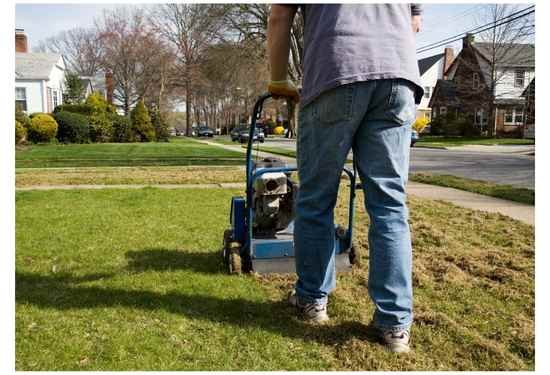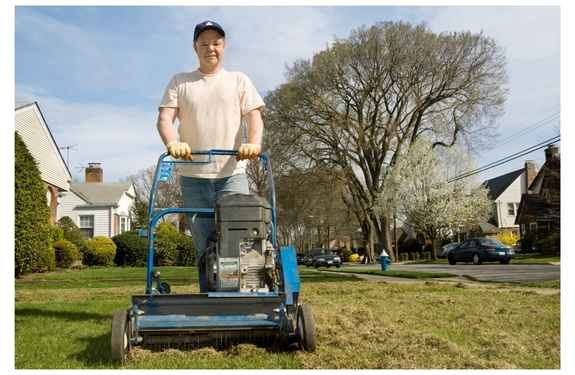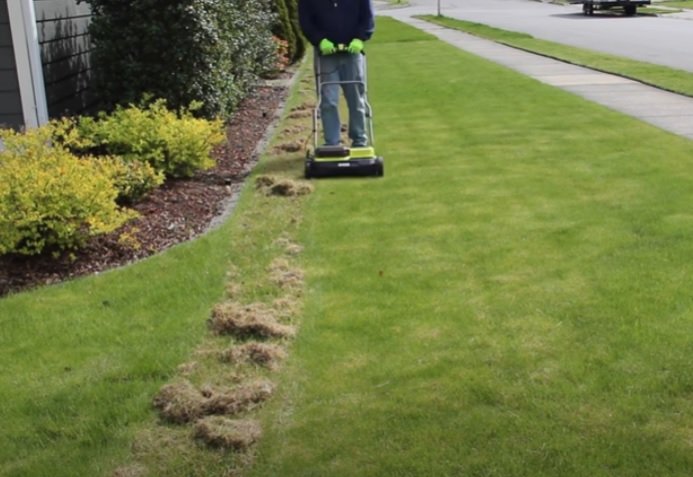We're an affiliate
We hope you love the products we recommend! Just so you know, we may collect a share of sales or other compensation from the links on this page. Thank you if you use our links, we really appreciate it!
Fall is a great time to dethatch your lawn. It will help you have a lush green lawn in the spring and that’s the primary goal. Right?
You will want to dethatch after the temperatures have moderated down below 85 degrees. Also, do your best to get it done at least a couple of weeks before the first frost if you can. You want to do it while the grass is still growing.
What Is Thatch?
Thatch is a layer of living and dead organic matter that accumulates on the surface of your lawn. It comprises things like grass clippings, dead leaves, and twigs. A small amount of thatch is actually beneficial to your lawn because it helps protect the roots from extreme temperatures and provides a little bit of insulation. However, too much thatch can be detrimental to your lawn because it can prevent water and nutrients from reaching the roots of your grass.
How Much Thatch Is Too Much?
If your lawn has more than ½ inch of thatch, it’s time to dethatch. You can tell you have too much thatch if the grass appears spongy when you walk on it, if the color is dull, or if you see a lot of weeds.
If you can’t really tell how much that you have by the above methods, here’s what to do. You can take a core sample of your lawn. All you need is a small gardening shovel or spade.
Take your spade. Dig out a small circle of dirt about 4 to 5 inches deep. When you remove the core, you will see layers. The top layer is the grass. You will see dead grass, leaves and twigs. Then you will see the thatch layer. It will be a soft, spongy layer of matter. This thatch layer consists of undecomposed organic matter.
What Is Dethatching A Lawn?
Dethatching a lawn is the process of removing the thatch layer from the grass. Then, picking up the debris that you have churned up, so it doesn’t smother the grass.
You can compost the thatch over the winter. Because it is partially broken down already, it will be ready to use by spring.

Can Dethatching Harm The Lawn?
Dethatching is removing the thatch layer from your lawn. It causes some mild stress to the lawn. That is why you need to do it while the grass is still growing.
If the lawn is too wet when you dethatch, you can pull up clumps of grass. Make sure the lawn is moist, but not wet and you will avoid this type of damage.
What Is The Best Way To Dethatch?
The best way to dethatch your lawn is to use a thatch rake, a power rake or a dethatcher.
A thatch rake is a manual rake that is good for very small yards. They are very labor intensive.
Moving on, the terms power rake and a dethatcher are sometimes used interchangeably. In reality, a power rake will remove the dead grass clippings, leaves and maybe a thin layer of mulch. A dethatcher will get down to about ½ below the top of the soil. It will remove more of the thatch layer that a “power rake” will.
A power rake is a machine that has rotating blades that quickly remove any dead grass, leaves, and other debris that may be on your lawn.

If you decide to dethatch, the best time to do it is in the fall. This is because the weather is cooler and there’s less chance of damaging your lawn.
Dethatching Equipment
If you’re thinking about dethatching your lawn this fall, there are a few things you’ll need to get the job done. You’ll need a power rake or dethatching machine. You can rent one from a local hardware store or rental company. These machines are very heavy and need a trailer or truck to haul them.
Now there are alternatives to these big machines. Sun Joe, Ryobi, GreenWorks and Worx all have small, electric or battery operated power rakes that are very affordable.
You’ll need to have a plan for disposing of the thatch that you rake up. Thatch is made up of dead grass, roots, and other organic matter. You can compost it or you can send it to the landfill.
Once you have all of your equipment, you’ll be ready to start dethatching your lawn. The process is fairly straightforward: simply run the power rake over your lawn in strips, being careful not to damage the live grass beneath the thatch layer. Rake up the thatch and dispose of it according to your plan.
With the smaller electric power rakes, you’ll want to start with the power rake drum and go over the lawn twice in different directions. Be sure to pick up the debris each time you go over the lawn. Then, put on the scarifier drum. This drum will remove the thatch. Go over the lawn two more times and you’ll be done.
This seems like a lot of work, but I have done it both ways. When you are on the rental clock, you don’t have the time to do as much as you originally wanted. You can spread the job out over a day with rests in between.
Should You do it Yourself or Call a Pro?
The lawn is an important part of the home. It is the first thing that guests see when they come over and it can make or break the curb appeal of a house. A well-manicured lawn says “welcome” to visitors, while a neglected one says “stay away.”
That being said, a beautiful lawn does not happen by itself. It takes time, effort, and knowledge to achieve and maintain a healthy lawn. One of the most important aspects of lawn care is dethatching.
There are two ways to dethatch a lawn: manually or with a machine. Manual dethatching is labor intensive and time-consuming, but it is also the more affordable option. Machine dethatching is less work for the homeowner, but it comes with a higher price tag.
So, which should you choose? If you have a small lawn, manual dethatching might be the way to go. But if you have a large lawn or if you simply don’t have the time to do it yourself, hiring a professional to do it for you might be the best solution.
If you have a sprinkler system, be sure to mark the sprinkler heads that are in the yard.
Common Causes Of Thatch
Thatch is a layer of organic matter that builds up on your lawn over time. It comprises things like dead leaves, grass clippings, and twigs.
– Not enough aeration: Aerating your lawn helps to break up compacted soil, allowing water and nutrients to reach the roots more easily. If you don’t aerate regularly, the soil can become too dense, leading to thatch buildup.
– Improper watering: If you don’t water deep enough, the roots will not go very far into the ground. This creates a root system that is close to the surface of the ground. This root system is vulnerable to dying off in the heat of the summer. Combat this by watering every 3 to 4 days, but water for longer stretches.
– Over fertilization: Applying too much fertilizer can cause thatch buildup because the extra nutrients encourage rapid growth of grasses and other plants.
– Mowing infrequently: Mowing grass that has grown tall puts stress on the grass plants. The grass clipping lay on top of the lawn and kill the grass underneath. These clippings can quickly add to thatch levels if they’re not removed from the lawn regularly.
If you have a thatch problem, the best solution is to dethatch your lawn in the fall. This will remove the excess thatch and give your lawn a fresh start for the next growing season.
Conclusion
There are a few things to consider when deciding whether to dethatch your lawn in the fall. The first is the amount of thatch that has built up. If it’s over 1/2 inch, it’s time to dethatch. The second is the type of grass you have. Some grasses are more prone to thatch than others. And finally, consider your climate. If you live in an area with a lot of rainfall, dethatching in the fall can help reduce the risk of mold and mildew. Whichever you decide, be sure to follow the proper steps to ensure a healthy lawn.


1 thought on “Should You Dethatch Your Lawn in the Fall?”